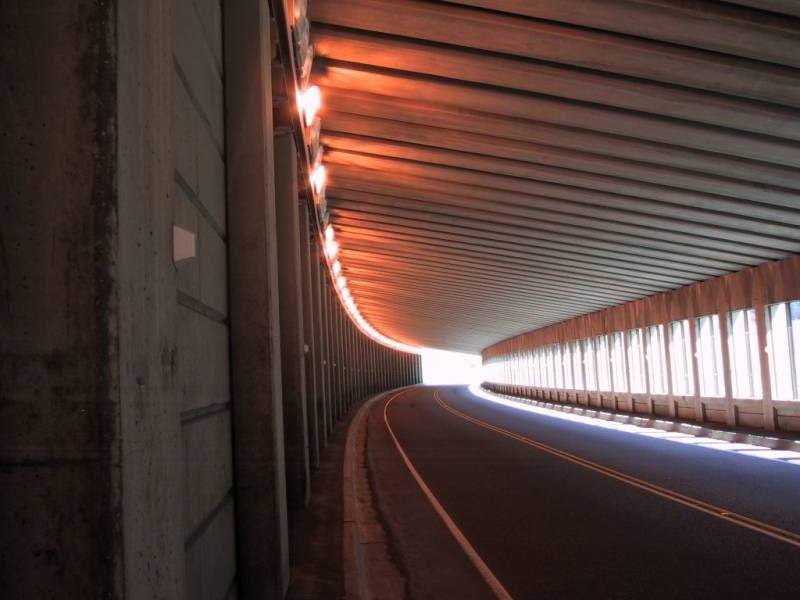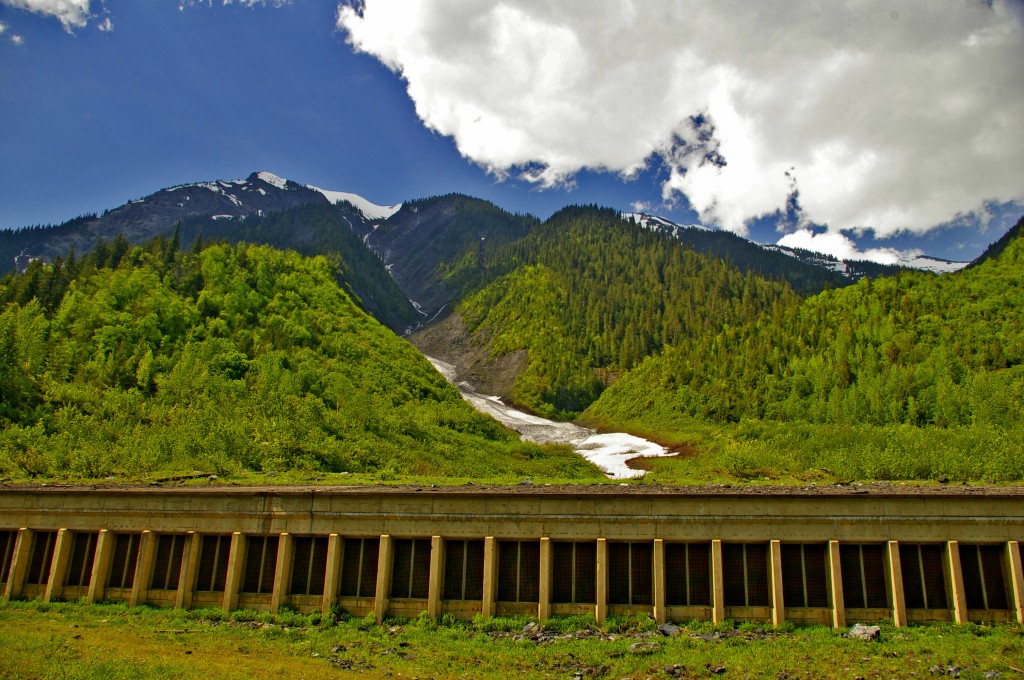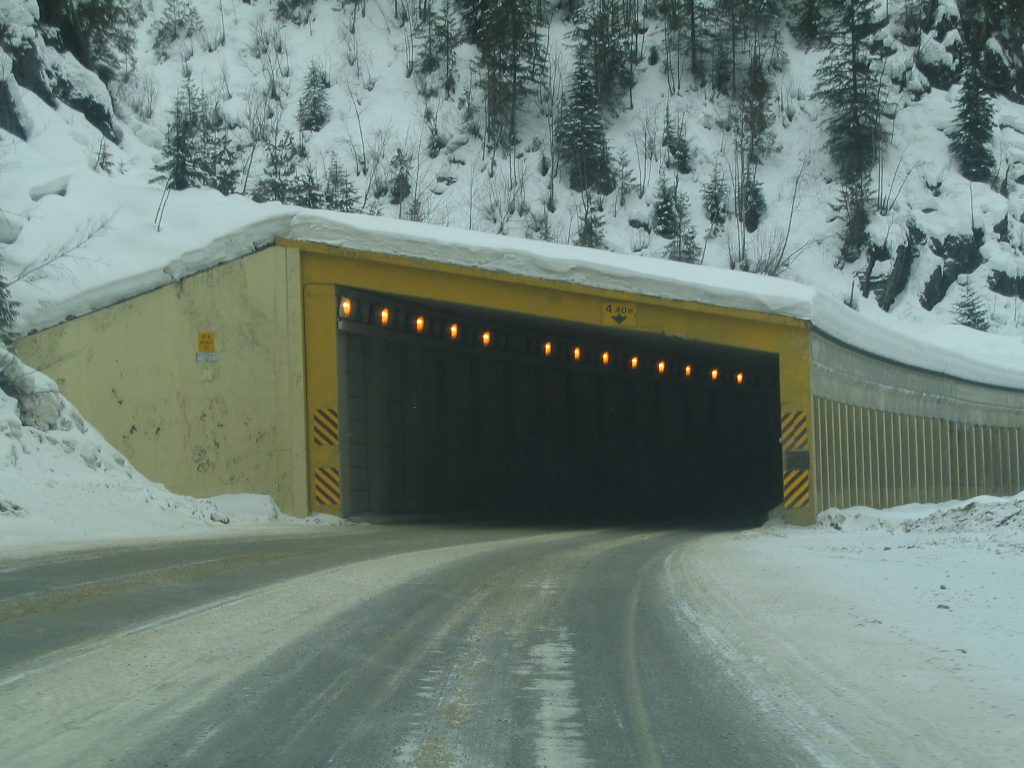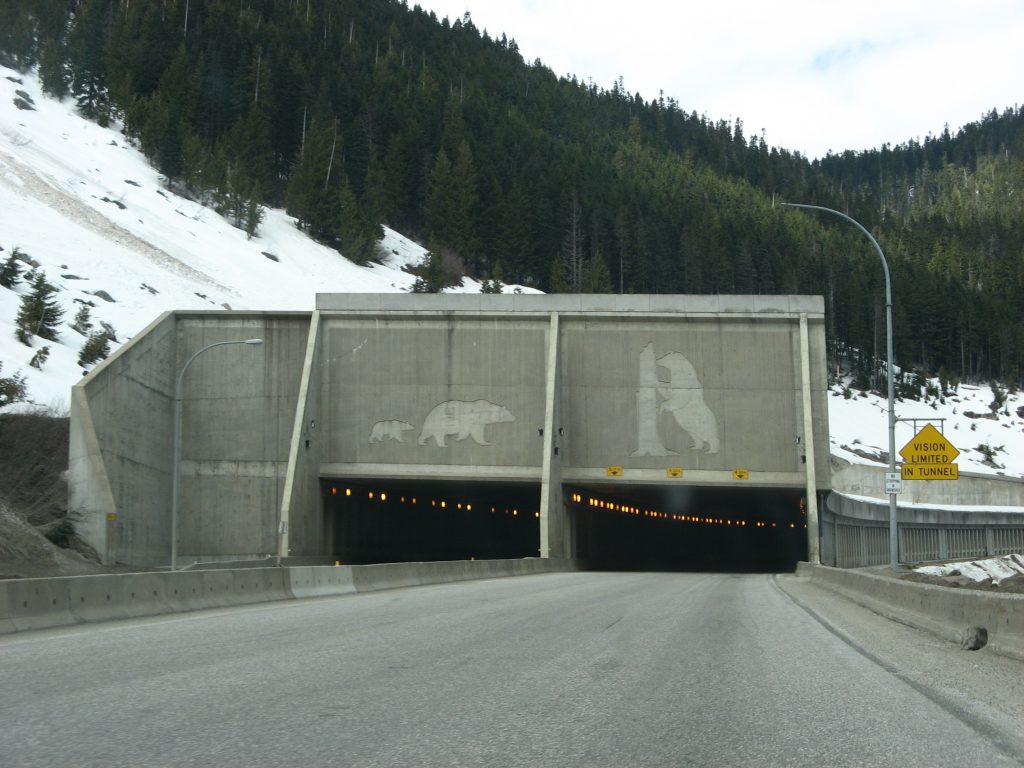
Have you ever heard the term, “snow shed” and wondered what it is? Well, it’s not a place where we keep extra snow. Actually, it’s more like a tunnel – a concrete cover built over the road to protect traffic from avalanches.
Snow sheds are designed to withstand the incredible forces involved with vast amounts of sliding snow, however they’re not meant to stop it. Instead, the sheds deflect the snow, allowing it to pass over top while traffic continues to flow underneath.
There are several snow sheds throughout the province, and Ministry looks after four of them: three on Highway 1 and one on Highway 5 (the Coquihalla). Parks Canada looks after five others, all located in Glacier National Park by Rogers Pass on Highway 1.
Snow sheds are an excellent way to keep travellers safe and traffic moving, but they’re not the only way we protect the roads.

Where the risk to the travelling public isn’t as severe, there are a number of simple, but very practical solutions. Things like earthen mounds to stop or turn avalanches away from the road, or catchment basins built just above the highway to catch snow and debris. While there are a lot of examples of these on our mountainous highways, it can sometimes be hard to pick them out. That’s because we usually encourage plants to grow on them to make them more stable and better able to handle an avalanche.
There are many other ways we keep travellers safe from avalanches, too. In fact, we’ve got teams dedicated to doing just that! Check out our overview of where, why and how avalanche control is done in Canada’s most mountainous province.


why don’t we install a shed on hwy 4 to deflect fire DeBerry and land slides and protect vehicles?!
Hi there, Dave.
Thanks for sharing your suggestion with us, we have passed it on for consideration. When we plan projects, analyzing options is a critical part of our process. We evaluate the pros of those options against their technical difficulty and cost to build and maintain. If a design includes tunnels while achieving the objectives within the available budget, they might become part of the final solution.
Thanks for connecting with us here.
What are the tiny cement huts along the side of the highway?
I thought they were for the sheep at first, but after reading this article and the contents, I’m wondering now if they are for people to hide in if there is an avalanche?
Hi there Anja – where did you see these huts?
Amazing extraordinarily and exquisite i love it it gives me so much info i just love it.
This was a short article. Maybe make it a little longer eh’ ?
Thanks for your feedback, Anonymous.
Wow, thanks so much for quoting our blog in your Road-trip 2022 blog, Tokeloshe: https://tokelosheblog.wordpress.com/2022/09/21/road-trip-2022/ Safe travels!
Here’s another question how long is the average snow shed?
Hi Quinton, the average length of a snowshed owned/managed by the BC Ministry of Transportation and Infrastructure is 232.5 metres. Lanark is 315, Great Bear is 285, Twins is 188 and Jack McDonald is 141 metres.
Hi, I wondered if we should be taking precautions for avalanches in the spring, summer and fall is it just for winter?
Hi Quinton, for drivers most parts of the province do not require precautions for avalanches in spring, summer and fall. The exception is Bear Pass, which can have avalanches as early as mid November and as late as May, due to its northwest coast location where there is a near constant supply of rain or snow. Given your interest in avalanche safety, you might enjoy this blog about Bear Pass (great video there) https://www.tranbc.ca/2012/04/20/avalanche-control-timing-train-travel-on-bear-pass/ and the latest technology used for avalanche control in that remote part of the province: https://www.tranbc.ca/2020/05/29/avalanche-control-gets-an-intelligent-radar-boost/
Thank you i feel like this can work because we need to stay safe
It is grate
I have always wondered if anyone has been in the snowsheds during an avalanche & if there is any footage of it?
Hi there Victoria – thanks for your question. Our avalanche technicians monitor snow conditions so closely, natural avalanche activity doesn’t really get a chance to happen, which means the chances of an avalanche happening while someone was travelling through the snowsheds are pretty slight. But not impossible. Hopefully your comment will connect you with someone who might have captured something like this.
Hi, are we able to park insid and take break for some time in the shed. It would be nice to have some vending machines available also and restroom if we got covered in ?
Hi there Choinch – if you are stopped inside an avalanche tunnel for any reason, please try to stay inside your vehicle. If the entrance or exits are blocked – we are doing everything we can to clear them. These structures are not intended as facilities other than to provide shelter for vehicles travelling through them. Hope that this is helpful.
I was wondering if the construction of a snow shed is cheap?
Hello,
Thanks for your question. The cost of constructing a snowshed depends on many factors. Is there somewhere specifically you are wondering about? We would be happy to share your question to our local area staff for their review. PS – we believe you’ve commented twice with two separate email addresses, so we will just be responding to this first one. Our apologies for any confusion – our system holds comments for our review, instead of simply posting the question directly to the page.
No I actuel researched about this and it was pretty expensive.
What is the absolute maximum height clearance on the snowsheds along the transcanda from golden to Revelstoke?Heading west?
Good morning Sherean,
Our Height Clearance tool on DriveBC will help you determine this measurement.
Here is the tool.
https://www.drivebc.ca/cvrp/index.html
Thanks for connecting with us!
Do you have any information regarding the Jack MacDonald the snow shed was named after? Regards
Good morning Vanessa – thanks for your message.
The most we could find on the origin of the name of this shed can be found here:
https://books.google.ca/books?id=ZY64jj0gQHQC&pg=PA30&lpg=PA30&dq=jack+macdonald+snowshed+name+origin&source=bl&ots=rLE1Wa10me&sig=ACfU3U0lCNcdXMT-LtLQ1goZAbg3zG4JUA&hl=en&sa=X&ved=2ahUKEwi6obPo4YftAhXjJDQIHU0LAGQQ6AEwCHoECAgQAg
Basically, the text indicates that Mr. MacDonald was a train engineer who died along the track in the area from an avalanche in 1937. Hope that this information is helpful.
Jack MacDonald was originally from Ballantyne’s Cove, Antigonish County, Nova Scotia. He was a son of Captain Angus MacDonald , a well known resident of the area who was awarded a silver teapot for his rescue of the British ship “Coronet” in Novemberr 1881. The teapot was presented by Queen Victoria in acknowledgement of his humanity and kindness to the shipwrecked crew of the ship “coronet” of Liverpool. He worked as a conductor for CP Rail. He was born in November 1885 and died in1937 when his train was hit by a snow silde and he was killed as a result. His brother Augustine ( born January 1887) also went to BC and was also killed in a snow slide in Everette Washington in March 1910.
Thanks for this history, G!
Do you know which companies built the four BC ministry snow sheds and when were they built?
Good morning Marlene – great question. We’ve asked and will let you know what we hear back.
Hello again Marlene,
Here’s what we found out:
The three snowsheds in Rogers Pass under our jurisdiction are Jack McDonald, Twin and Lannark. These snowsheds were completed in 1963 by Choukalos, Woodburn & & McKenzie LTD. Consulting Engineers.
The Great Bear Snowshed on BC Highway 5, the Coquihalla, was completed in 1986 by Kerkhoff Construction.
We hope this is helpful!
Hi
Like to know the Number if Snowsheds here in B.C. and their specific names for each ONE , Please and Thank You as well as their respective lengths in meters too
I know Rogers’ Pass has its’own 31 snowsheds
Good morning Peter – thanks for your question – we are looking into this for you and will let you know when we have more information.
Hi again Peter – here’s what we heard back.
There are only four snowsheds under provincial jurisdiction (the others which are located in national parks are under federal jurisdiction).
Region Contract Area Structure No Structure Name Structure Type Structure Status Type Code Total Length Structure Function Type Code
2 – Southern Interior Region 12 – Selkirk CA 01694 JACK MACDONALD SHED TUNNEL F 140.8 L
2 – Southern Interior Region 12 – Selkirk CA 01695 TWINS SNOW SHED TUNNEL F 187.8 L
2 – Southern Interior Region 12 – Selkirk CA 01696 LANARK SNOW SHED TUNNEL F 315.8 L
2 – Southern Interior Region 14 – Nicola CA 02850 GREAT BEAR SNOW SHED TUNNEL F 284.7 L
On March 6 2018 while travelling the Rogers Pass, the snow sheds did not have any lights on. So when entering the snow sheds it was pitch black, there is nowhere to pull over in that area to clean off your headlights when they are covered in slush ,ice or salt before entering any of the snow sheds. Supposedly there is a maintenance shed at the Rogers Pass Summit, the crew in there should be checking this out on a daily basis at any time ensuring that the lights are functioning. Maybe I will contact Global Television who will come out to see my complaint. I hope on my return trip that they will be on.
Hello Doug,
As a federally operated national park, the road and infrastructure in Glacier (including Rogers Pass) is under the care and maintenance of Parks Canada. While we work closely with them on either side of this area, you will need to connect with them directly to share your concern. Here’s their contact information: https://www.pc.gc.ca/en/pn-np/bc/glacier/info/contact
hi
Hi there!
Re: snowshed, Coquihalla Hwy. A suggestion for emergency signage at or near the Zopkios brake check area before the downhill approach to the Sonwshed. I always worry that there is an accident in the snowshed, the curve in the snowshed hides any incident in the snowshed. As I descend the hill I always check that traffic is coming out the south end of the snowshed as an indicator that there isn’t likely an accident in the shed. I drive the Coquihalla up to 10 times per year and have since it opened. Fortunately, there has not been an accident when I’ve gone through the shed. If there was, there would be chains of secondary accidents as cars and trucks plow non stop into the stopped vehicles. If there is an accident in the snowshed, there should be emergency, highly visible signage southbound near the exit of the Zopkios brake check, that would give drivers, especially of trucks to slow down and stop if needed. The Ministry would need to figure out how the signage would be triggered though, in time to be effective without false positives. Also the speed down hill at 120 km/hr is too fast for anyone to stop in time by the time they see an accident in the snowshed. Please take some action to mitigate the risks in the snowshed.
Hi Tony,
Thanks for sharing your long experience with driving the Coquihalla Highway, and your thoughtful suggestions to improve safety around the snowshed and Zopkios brake check area. I will forward your comments to our people who are responsible for the Coq.
Hi Tony,
The folks in the district tell me that we now have an overhead changeable message sign at Falls Lake, just prior to the Zopkias Brake check that can provide warnings and advice.
With the new variable speed zone, regulatory speeds will be adjusted as congestion occurs, to improve safety. See: http://tranbc.ca/2015/12/02/variablespeedlimitsigns/#sthash.5nwan0Na.dpbs Please note, installation of the variable speed zone system was just completed and is currently under configuration and monitoring. Additional signage may be considered.
There also have been signage upgrades along the down gradiant on approach to the snowshed, to warn of limited visibility within the snowshed.
I hope you find these recent improvements beneficial.
I noticed a few of the highway workers shoveling a circular area off to the side of the road (in multiple spots) before a planned avalanche control on the Rogers pass. What were they doing??thanks
Hi Vin,
Good question! These circular platforms are locations where 105mm howitzers are placed. The howitzer fires a projectile with pin point accuracy to avalanche start zone target points during highway closures to create artificial avalanches. There are 2 kg of high explosive that detonate on contact creating a very effective trigger. This method of control ensures safety to highway users and minimizes duration of avalanche related highway closures. Rogers Pass is a federally maintained portion of BC Highway 1. Here is a link for more information: http://www.theglobeandmail.com/news/british-columbia/protecting-the-pass-military-fires-shells-into-mountains-to-limit-avalanches/article23368022/
Hope that this helps. Thanks for connecting with us here.
THIS IS THE BEST ARTICLE EVER amazing job! i would love to see more of these in the future.
We travel the Hwy one to Calgary a few times every year. Why do not all the snow sheds have ights in them. There appears to be power readily available. Then even with lights they are not always on. I find this unbelievable and extremely dangerous. People have died in them.
Hi Brian,
Good question! All snow sheds on BC highways under the control of the provincial government have lights. However, some portions of BC highways fall under the jurisdiction of the federal government (those in federally controlled national parks specifically) and the stretch of BC highway 1 in Rogers Pass is one of them. Because of the remote location of federal parks, federal snow sheds often do not have an accessible power source to add lights, and therefore rely on people turning their headlights on, which therefore replicates nighttime driving. Hope that this helps. Here is a blog with a bit more information about federally vs provincially run highways: http://tranbc.ca/2013/06/25/share-and-share-alike-federal-sections-on-provincial-highways/#sthash.uocqnabM.dpbs